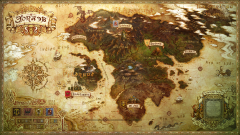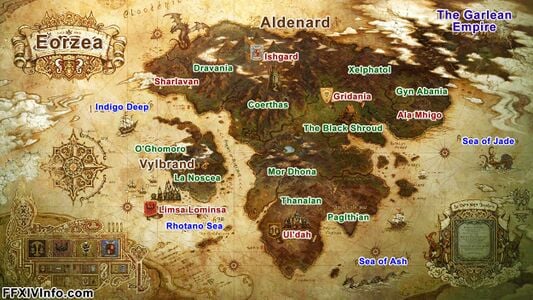Eorzea
“Eorzea. A land embraced by gods and forged by heroes. The bountiful aether that flows through this lush realm has ensured the peace and prosperity of its peoples for generations.
— In-game description
Eorzea is a realm that comprises the continent of Aldenard—westernmost of the Three Great Continents—and its surrounding islands, most notably the island of Vylbrand. Often called a land "embraced by gods and forged by heroes," Eorzea has played a central role in many major historical events, such as the rise of the Allagan Empire or the Battle of Silvertear Skies. In recent years, its conquest has become the focus of the Garlean Empire, causing the city-states of the realm to join together and form the Eorzean Alliance.
Geography
Eorzea is made up of Aldenard and its surrounding islands, the largest of which is Vylbrand. The realm is home to the deserts of Thanalan and plains of Paglth'an in the south, the lush forests of the Black Shroud and Lake Silvertear in Mor Dhona at its heart, the vast mountain range Abalathia's Spine to its north, and the island of Vylbrand—home to La Noscea and Mt. O'Ghomoro off its western coast.
The so-called Five Seas border the realm, the Bloodbrine Sea to its north, Indigo Deep to its west, the Rhotano Sea between Vylbrand and Aldenard, the Sea of Ash to its south, and the Sea of Jade to its east. Surrounding the realm are various islands including the Cieldalaes archipelago south of Vylbrand, and Mazlaya and the Pearl in the Rothlyt Sound southeast of the Black Shroud.
Locations
- La Noscea
- Thanalan
- The Black Shroud
- Coerthas
- Mor Dhona
- Abalathia's Spine
- Dravania
- Gyr Abania
- O'Ghomoro
- Paglth'an
- Xelphatol
- The Cieldalaes
- Carteneau Flats
- Yafaem Saltmoor
- The Farreach
- The Pearl
- Mazlaya
Major Cities
The peoples of Eorzea congregate in city-states, small, independent nations consisting of a single city and its dependent territories. During the majority of the Sixth Astral Era, there stood six city-states, but by the beginning of the Seventh Umbral Era, only four remained. The city-state of Ala Mhigo fell to the Garlean Empire, and the scholars of Sharlayan abandoned their city to return to Old Sharlayan in the Northern Empty.
Ruined City-States
Though four city-states still stand in Eorzea, there were six others that prospered in previous Astral Eras. These city-states were either abandoned or had fallen as a result of Calamities or other conflicts.
Population
Eorzea is home to many members of the wandering races. The most prevalent race is the Hyur, with the Midlander clan being the most prolific among them. It is also home to members of the Elezen, Roegadyn, Lalafell, and Miqo'te races. The Au Ra are a small minority in the realm, as they are native to the Far Eastern continent of Othard and not commonly found in the west.
Apart from human races, Eorzea is also the homeland of myriad other Spoken races (sometimes known as beastmen), such as the Amalj'aa tribe of Paglth'an, Ixal of Xelphatol, Kobolds of O'Ghomoro, Sahagin of Indigo Deep, and Sylphs of the Sylphlands.
Images
Lore
“Comprised of Aldenard, the westernmost of the Three Great Continents, and its surrounding islands, the realm of Eorzea has, throughout history, been the cradle of several unique civilizations. Rich in aether and blessed with an abundance of natural resources, it is often said to be “embraced by gods” in reference to the Twelve─the pillars upon which the religious faith of many Eorzeans firmly rests.
As recently as a few decades ago, the six city-states of Eorzea coexisted in an age of relative stability. Alas, this peace was shattered in the year 1557 of the Sixth Astral Era, when the Garlean Empire embarked upon a campaign of Eorzean conquest. Ala Mhigo soon fell, and the promise of continued violence saw the nation of Sharlayan abandon its Dravanian colony, recalling its citizens to the motherland in the northern seas. In this way was Eorzea plunged once more into an age of strife.
The Seventh Umbral Calamity followed, bringing with it unspeakable devastation, but the resilient people of Eorzea endured. Joining hands in common cause, they eventually succeeded in defeating the imperial invaders. In Ishgard, the millennium-long Dragonsong War was later brought to an end, and after a joint campaign by the Eorzean Alliance and the Ala Mhigan Resistance, the twenty-year Garlean occupation of Ala Mhigo ended in liberation. Thus did the realm obtain a measure of peace.
Charting The Contnents
A map of Eorzea, with the continent of Aldenard at its center, has long been an indispensable item for adventurers and peddlers alike. Recently, however, its place in the inventory of the well traveled is being taken by an expanded work of cartography which includes the entirety of the ‘Three Great Continents. The following is a history of this greater map’s creation, and a detailed overview of the geography depicted thereon.
It Begins With A Single Step
Men have been attempting to capture the shape of the world on parchment since days of old. Based upon folklore and guesswork, many of these maps were akin to illustrated scrolls of myth and legend, and, while beautiful to look upon, were riddled with terrible inaccuracies.
Such works became redundant with the appearance of a truly com- prehensive portrayal of Eorzea and its regions. Roddard Ironheart, an ‘explorer of great renown, spent decades traversing the realm on foot that he might chart the lay of the land with his own two eyes. His dedication resulted in a work of unmatched precision, affording travelers the first map with which one could reliably plan far-reaching journeys.
‘The question, then, is what drove Roddard to draft this cartographical masterpiece? To understand his motives, it is necessary to learn the circumstances of his birth, and trace the path of his earliest meanderings.
Roddard was born to a pair of performers who belonged to a traveling troupe—his father a lute player and his mother a dancer. They raised their son on the road, the rattling planks of a chocobo-drawn cart serving as Roddard’s first home. Considering the ever-changing scenery of his childhood, it is small wonder that the man he became could never settle in one place for long. When Roddard came of age, a tall and gangly youth, he inherited his father’s lute, and struck out to travel the roads alone.
His was a life of ceaseless motion, walking hither and yon for malms at a time, halting only to strum songs for his daily bread before moving on to the next town and the next audience. Soon, however, Roddard found that his sedate journeys from village to town, and town to city, were unable to sate his growing wanderlust.
Thus did he lay plans to venture to a place uncharted and unseen by any explorer: the mythical plains of Paglth'an. From the outset, it was an endeavor doomed to catastrophe.
To reach the ancestral home of the Amalj'aa, Roddard needed to cross the badlands to the northeastern edge of Thanalan. The map he had purchased in an Ul’dahn back alley, however, was a less-than-authentic representation of the terrain. Unsure of his direction, the hapless adven- turer stumbled through the sun-blasted rocks for four days, until he finally collapsed from exhaustion. Yet even as the path to Thal’s hall stretched out before him, Roddard was rescued from his fate by a passing caravan.
The near-fatal experience instilled within the young man a profound respect for the importance of preparation and dependable cartography, and it was shortly after his misadventure that Roddard Ironheart—the now-legendary explorer—would embark upon a lifelong expedition to draft a true and accurate rendition of all the lands of Eorzea.[1]
Cartography Of Eorzea And The Three Great Continents
Following decades of careful exploration, Roddard Ironheart completed his map of Eorzea in the 1,506th year of the Sixth Astral Era. The day he unveiled the finished work, he inscribed these words onto the crisp new parchment: “A map is as precise as the malms walked in her making, yet I fear these feet have but far too few between them. May she serve faithfully any who would employ her for good, and shun all who would fill her borders with blood. Twelve see the steps taken by those who heed her humble guidance ensure her legacy endures.”
For seventy years now, those who inherited Ironheart’s name, or even simply his passion, have been encouraged by his words to expand upon his original work. And their additions have not been confined to the continent of Aldenard. Intrepid cartographers have ventured to the shores of Ilsabard and Othard, and even charted the islands of Hingashi in the distant east. These findings have been printed together on a single scroll to create a map of the Three Great Continents—a comparatively recent work which is rapidly becoming the standard for navigators and explorers across Hydaelyn.
Stretching between Eorzea and the lands of the east is the Garlean-con- trolled continent of Ilsabard. Owing to the imperial military’s disinterest in seafaring, however, its naval presence is small, and travelers who remain a safe distance from the coastline risk little chance of reprisal. On the contrary, Limsa Lominsan privateers—emboldened by the success of Operation Archon—prowl the waters of the Bounty, and prey upon the Empire’s ships with relative impunity. It is thus possible for even a humble trading vessel to avoid imperial interference by sailing across the Sirensong Sea or the Drown, and arrive in the Far East via the “Southern Sea Road.” Connecting Eorzea to the independent Near Eastern city-state of Radz-at-Han, this route offers its own perils, not the least of which are its swift and unpredictable currents. Despite these dangers, more and more travelers are visiting the exotic ports of the Ruby Sea, and eager mapmakers are slowly but surely capturing the regions geography with ink and parchment.
Refinements are being made not only to maps of the Far East but to those of territories within Eorzea as well. The end of the Dragonsong War culminated in a political shift within the walls of Ishgard, and the heretofore isolated nation has once again flung open its gates to outside visitors. Cartographers have since been able to fill in that region of the Three Great Continents with near-forgotten locations, including the majestic Sohm Al and the towering Cenotaph, symbol of the newly repopulated town of Idyllshire. Such significant additions often thus reflect the march of history itself.
The carefully rolled wares of a map merchant. In a capital city such as Ul’dah, where traders gather from across the realm, it is no difficult task to locate a seller of charts and maps. Meticulous depictions of Eorzea and the Three Great Continents; smaller regional maps of Thanalan, La Noscea, and the Black Shroud; and even enlarged diagrams of highly specific territories can all be had for a price.[2]
References

